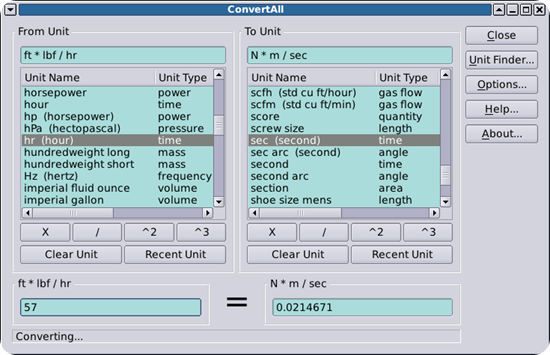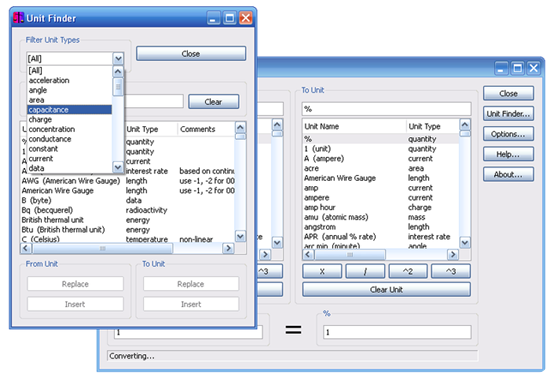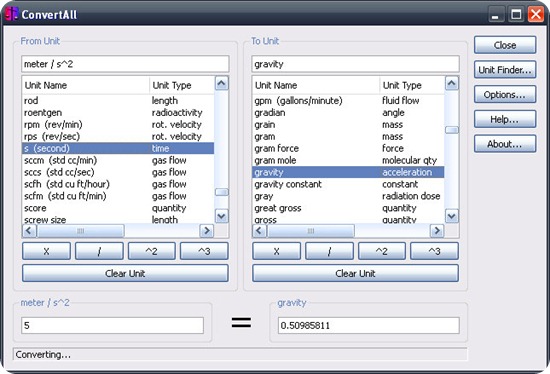 With ConvertAll, you can combine the units any way you want. If you want to convert from inches per decade, that's fine. Or from meter-pounds. Or from cubic nautical miles. The units don't have to make sense to anyone else.
With ConvertAll, you can combine the units any way you want. If you want to convert from inches per decade, that's fine. Or from meter-pounds. Or from cubic nautical miles. The units don't have to make sense to anyone else.
Features
- The base units for conversion may be either typed (with auto-completion) or selected from a list.
- Units may be selected using either an abbreviation or a full name.
- Units may be combined with the "*" and "/" operators.
- Units may be raised to powers with the "^" operator.
- Units in the denominator may be grouped with parenthesis.
- Units with non-linear scales, such as temperature, can also be converted.
- A unit list may be filtered and searched
- Recently used unit combinations may be picked from a menu.
- Numbers may be entered on either the "From" or the "To" units side, for conversions in both directions.
- Basic mathematical expressions may be entered in place of numbers.
- Options control the formatting of numerical results.
- The unit data includes over 500 units.
- The format of the unit data file makes it easy to add additional units.
- Command line options are available to do conversions without the GUI.
ConvertAll requires the following libraries:
Qt (Version 4.1 or higher - see Trolltech for more information)
Python (Version 2.3 or higher)
PyQt (Version 4.0 or higher - see Riverbank for more information)
Download.
On a Linux system that has the libraries noted on the requirements page, all that is needed is the source code (with an install script), included in convertall-0.5.2.tar.gz (60 KB).
To install user interface and documentation translations for ConvertAll (French, German and Spanish are currently available), also download convertall-i18n-0.5.2a.tar.gz (140 KB).
But please read about the installation and use of ConvertAll. This information is available on this site and in the ReadMe file inside the above tar file.
Install.
Extract the source files from the convertall tar file, then change to the ConvertAll directory in a terminal. For a basic installation, simply execute the following command as root: python install.py
To see all install options, use: python install.py -h
To install ConvertAll with a different prefix (the default is /usr/local), use: python install.py -p /prefix/path
To install language translations for ConvertAll, download the "convertall-i18n-..." tar file that matches the version number of the main ConvertAll file (ignore the letter suffix on the translation version number). To install the program and translation files simultaneously, extract the translation file from the same directory where the main convertall tar file was extracted and run the install command as described above. If ConvertAll is already installed, extract the translation file to any directory and run the translation's install command as described above.
The real strength of ConvertAll lies in its ability to combine multiple units. Simply type the unit names with an '*' or a '/' between them. This allows the entry of units such as "ft*lbf" or "mi/hr". The '^' symbol may be used for exponents, such as "ft^3" or "ft*lbm/sec^2". Negative exponents are allowed for units such as "sec^-1" (per second), but may switch the multiplication or division symbol ("ft*sec^-2" becomes "ft/sec^2").
Multiplication and division have the same precedence, so they are evaluated left-to-right. Parenthesis may also be used to group units in the denominator. So "m / sec / kg" can also be entered as "m / (sec * kg)". The version with parenthesis is probably less confusing.
The buttons below the unit lists ('X', '/', '^2', '^3') will also place the operators after the unit nearest to the cursor. The exponent keys will replace the unit's exponent.
Similarly, clicking on a unit from the list generally replaces the unit nearest the cursor.
The "Clear Unit" button below the operator buttons may be used to empty the unit edit window to allow a new unit to be entered
Options.
The "Options..." button allows for changing several default settings. These settings are automatically stored so that ConvertAll will re-start with the settings last used.
The first options control the display of numerical results, including the use of scientific notation and the number of decimal places. Be cautious about setting the number of decimal places to a low value, which can result in a significant loss of accuracy. Six places or higher is recommended (eight is the default).
There is an option to set the number of recent units to be saved. Setting it to zero will disable the Recent Unit buttons.
There is an option to hide the operator text option buttons (x, /, ^2, ^3, Clear Unit and Recent Unit). These can be hidden to save space if the keyboard will be used to enter the operators.
Buttons are also included on the options dialog to control the colors of the text fields.
If you liked this article, subscribe to the feed by clicking the image below to keep informed about new contents of the blog:











0 commenti:
Post a Comment